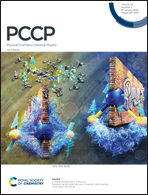Mechanistic understanding of the increased photoactivity of TiO2 nanosheets upon tantalum doping†
Abstract
Anatase TiO2 is doped with Ta cations through a hydrothermal route. Based on X-ray photoelectron spectroscopy and X-ray absorption near-edge structure spectroscopy, the Ta dopants exist in the 5+-oxidation state. The oxidation state is insensitive to the Ta loading amount. Extended X-ray absorption fine structure spectroscopy confirms that the local structure around Ta cations is not identical between the Ta-doped samples. The Ta–O distance monotonically increases with the Ta loading amount due to a gradually expanding lattice. The Ta-doped samples show higher activity than pristine TiO2 for photomineralizing recalcitrant organics. The enhanced photocatalytic activity is proposed to be due to an enhanced population of photoexcited electrons, as probed using light-induced IR absorption spectroscopy, and an extended electron lifetime, as probed using time-resolved microwave conductivity, which are associated with the formation of Ti3+ defect states acting as shallow electron traps. The maximum photocatalytic activity is observed for TiO2 doped with 2 mol% of Ta, which shows enhancement of mineralization efficiency (about 3 times) and enhancement of electron population (up to 20 times), as compared to those of pristine TiO2. The fundamental question of why a proper metal doping into TiO2 increases photocatalytic activity is discussed in this study.



 Please wait while we load your content...
Please wait while we load your content...